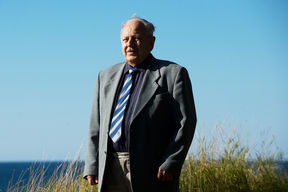Successful university cooperation in marine technology between Finland and Estonia

Professor of mechanics Jaan Metsaveer of Tallinn University of Technology took the initiative in the 1990s to restart Estonian university-level research and teaching in shipbuilding together with the Finns. The background was the sinking of the passenger-car ferry M/S Estonia in 1994 in the Baltic Sea and the subsequent extensive investigations into the causes of the accident.
Metsaveer served as a member of the international committee assembled to investigate the accident, and stated in an interview: "M/S Estonia was destroyed because at the time science was not able to analyse everything necessary".
University education in shipbuilding had been started in Tallinn after the war, in 1950, but it ended just as it was getting off the ground, and moved to Leningrad. Estonians were not very interested in studying sudostronie in Leningrad, and Estonian expertise in the field waned as a result. In 1958, Metsaveer was among the last to graduate from the ship repair science department of Tallinn Polytechnic Institute, which operates today as the Tallinn University of Technology (TalTech). In 1980, Metsaveer completed his doctoral degree in physics and mathematics at Moscow State University.
Master's education in marine technology
Educational cooperation between Finland and Estonia started in the 1990s, and, as a result, dozens of Estonian students have graduated with master’s degrees in marine technology from Helsinki University of Technology (HUT) and its successor, Aalto University. Five of these students have also completed doctoral degrees in technology. Before moving to Finland, the students completed their bachelor's degrees in engineering at TalTech. Adapting to a new environment in Otaniemi was aided by the fact that many Estonian students knew the Finnish language in addition to English and also had a genuine desire to improve their language skills.
The most important course in the marine technology curriculum is an extensive ship design project that lasts almost a year and is carried out by students in pairs. Through this course, Estonian students got to know the challenges of ship design and learned to use its modern tools. At the end of the 1970s, Professor Ernst Enkvist had created the content of the course while working as a professor of naval architecture. The subjects of the master’s theses were on one hand related to the research projects of the marine technology group in Otaniemi, and the maritime industry's own development projects on the other. Master’s theses were written in English. Summer internships offered the Estonian students opportunities to get to know the Finnish maritime industry in practice as well as marine technology research at the university.
Dissertations created through research
Since the 1960s, the design and construction of cruise ships has been a key area of expertise for the Finnish maritime industry. The design and dimensioning of the hull structure of cruise ships is a very challenging task that requires in-depth theoretical knowledge. The development of numerical calculation methods and computers has improved our understanding of the strength and vibration response of these ships. The marine technology research group at Aalto University has close cooperation with industry in both domestic and international research projects. Cooperation with the Meyer Turku shipyard has been particularly successful. The content of the dissertations prepared by Estonian doctoral students is presented in brief below.
Structural study of cruise ships
Hendrik Naar, D.Sc. (Tech.), focused in his dissertation (Ultimate Strength of Hull Girder for Passenger Ships, 2006, supervisor Petri Varsta) on the ultimate strength of the hull girder of large, post-Panamax-class cruise ships. The hull structure of a cruise ship is characterized by numerous decks and openings in the superstructure, as a result of which the hull structure does not follow the classical beam theory as in most ship types. Naar developed the theory of coupled beams, the results of which were validated using the finite element method. The research was done as part of a EU project in cooperation with Meyer Turku. Currently, Naar works as a senior structural analyst at Marine Engineering Company (MEC) and holds the title of docent at TalTech.
The fatigue design of a thin, less than five-millimetre-thick welded deck plate of a cruise ship is challenging due to the large initial distortions caused by welding. In her doctoral thesis (Fatigue Assessment of Thin Superstructure Decks, 2014, supervisor Heikki Remes), Ingrit Lillemäe, D.Sc. (Tech.), investigated the effect of deformations on fatigue strength by utilizing the nonlinear element method. The results showed that the current international dimensioning method in the industry is suitable for evaluating the fatigue strength of the hull beam, but not for a deck plate with weld joints. Lillemäe (now Lillemäe-Avi) works in Tallinn as a senior designer at the LTH-Baas company.
Predicting the strength and vibration response of a modern cruise ship is a challenging task. Eero Avi, D.Sc. (Tech.), investigated in his dissertation (Equivalent Shell Element for Passenger Ship Structural Design, 2021, supervisor Jani Romanoff) the elemental modelling of the hull structure of a cruise ship, where the stiffened panel of the ship is modelled with one equivalent element, enabling efficient structural optimization. The work was done at the Meyer Turku shipyard and was an excellent example of transferring academic knowledge into practice. The key person in the implementation of this collaboration was Ari Niemelä, M.Sc. (Tech.), (D.Sc. (Tech), h. c.), who is responsible for the shipyard’s structural basic design. Avi works as a chief expert in new building projects at the Estonian State Fleet.
Collision of ships
At the turn of the millennium, questions related to the collision of ships became an object of interest in international research cooperation. The dynamics of collisions, the response of the hull structure, and the progressive flooding into and within the ship's hull were the subjects of research in the Otaniemi marine technology group. Two dissertations were completed on this topic by Estonian doctoral students.
The dissertation (Dynamics of Ship Collisions, 2010, supervisor Petri Varsta) of Kristjan Tabri, D.Sc. (Tech.), aimed to identify the phenomena related to the dynamics of ship collisions through model experiments and calculations. The starting point for the research was provided by a full-scale collision test performed in the Netherlands, where the energy balance of the collision remained unclear. The result of the dissertation was a computational model that enables the quick analysis of a ship's structural and motion response in collisions. Tabri works as a professor of marine technology at TalTech.
Mihkel Körgesaar, D.Sc. (Tech.), chose as the focus of his dissertation (Modelling Fracture in Large Structures, 2014, supervisor Jani Romanoff) the consequences of a collision in the ship's hull structure. The practical question was how to model ductile fracture propagation with large shell elements. The results of the work can be used in the design of the ship's hull structure, and thus improve the collision resistance of the shell. Körgesaar works as a marine technology professor at TalTech.
Starting operations in Estonia
For the Estonian marine technology experts to return from Finland, they would have to be able to find employment in Estonia. The most effective solution, in the initial phase, was to start with consulting. In 2002, Aalto University marine technology students Meelis Mäesalu, Hendrik Naar and Kristjan Tabri founded a consultancy company in Tallinn, called MEC. Its area of expertise is ship design and the most challenging strength analyses of marine structures. Since the company’s founding, Meelis Mäesalu, Lic. (Tech.), has worked as the CEO of MEC. Over the years, the company has participated in more than 400 domestic and foreign projects and currently employs a dozen people.
The challenge in Estonia in the 2010s was to start university teaching and research in marine technology. The first attempt was made in 2018, when Mihkel Körgesaar was appointed professor of marine technology at TalTech's Estonian Maritime Academy, whose primary task is the training of seafarers. Combining technology education with seafaring did not prove to be a workable solution, however, and the decision was made to establish TalTech's Kuressaare College in Saaremaa with a focus on the blue economy. The education programmes it offers are a bachelor's degree in environmentally friendly technology and master’s and doctoral degrees in marine technology. In addition, the Maritime Technology Expertise Centre (MARTE) offers research and development services for marine exploitation. An experimental basin for the study of hydrodynamic phenomena was also built in Kuressaare.
As a result of doctoral education in marine technology, a couple of doctorates in technology have already been completed in Estonia. In recent years, the investigation into the sinking of M/S Estonia has been resumed, with Professor Kristjan Tabri serving as an expert. He and Professor Mihkel Körgesaar are among the country’s key promoters of marine technology and science.
Giving thanks
Professor Jaan Metsaveer died on 13 February 2024, in Tallinn. Before his passing, Metsaveer got to see the main goal of the education project realized, as university activity in marine technology as an independent engineering discipline resumed at Tallinn University of Technology. The marine technology group at Aalto University and the numerous academic shipbuilders of the new Estonia remember him with great warmth, and mourn his passing.
Text: Petri Varsta, professor emeritus of marine technology
- Published:
- Updated:
Read more news

Workshop day for teachers: 360° environments and podcasts
On Tuesday 4.6. a workshop day consisting of 360° environment creation and podcast production provides a way to get to know these media in practice. Feel free to join both workshops or one of them according to your time and interest.
Aalto EE Introduces Alex: A New Learning Experience Platform to Transform Lifewide Learning and Tackle Upskilling Challenges
Aalto University Executive Education (Aalto EE) is launching the first version of Alex in June, a learning platform designed to enhance continuous professional development. Alex offers personalized learning journeys, micro-credentials, and professional development programs, aligning current skills with industry needs. This platform, which continuously evolves with new features like mobile access and AI integration, sets a new standard for professional development in Finland.
Aalto ARTS Summer School explores the significance of water through the lens of art
The theme of School of Arts, Design and Architecture’s Summer School this year is water, and its significance is explored in a multidisciplinary way through the perspectives of art, film and digital.